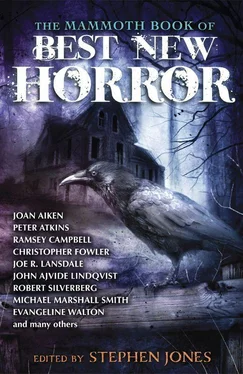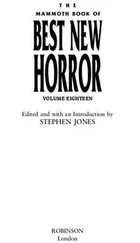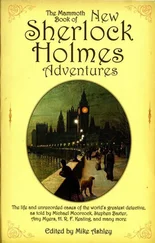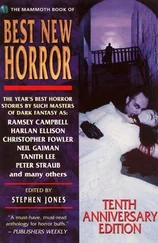After dinner the Dean spends some time in his study before retiring to bed writing letters and making notes for the forthcoming chapter meeting. His wife passes by his study door twice bearing an oil lamp. She has taken to these nocturnal perambulations lately because she cannot sleep. On the second occasion, it being close on midnight, she looks in to remind her husband of the fact and finds him not writing, but staring dully at the dying embers of his fire. When he becomes aware of her presence he starts violently and stares at her as if she were a stranger. Coolly Mrs Coombe reminds him of the hour, a remark which he dismisses with a perfunctory: “Thank you, my dear.” Soon afterwards she hears his heavy tread on the stairs as he goes to his bedroom.
Unlike his wife Dean Coombe is accustomed to sleeping soundly, and it is one of the reasons why he sleeps apart from his wife. She would plague him far into the night with troublesome questions and admonitions if they still shared a bed. She has acquired a habit of discontent of late and he lacks the imagination to supply the remedy.
His own bedroom is small, for Mrs Coombe occupies the offi-cial matrimonial chamber, but it has a fine view over the close, and from the bed, if the curtains are open, you may just see the western front of St Anselm’s. Dean Coombe does not close the curtains because he likes to imagine himself the guardian of this great edifice, keeping watch over it by day and night.
Once his night-shirt is on the Dean feels suddenly exhausted, but still he kneels dutifully by the bed to say his prayers. But when he has climbed into bed he falls almost immediately into a heavy sleep from which two hours later he is awakened with almost equal suddenness.
The moon is up and shines across his bedchamber with a clear cold light. Coombe thinks he has been awakened by a noise, but all is silence. Then he hears a sound. It is like wings fluttering in a confined space, a bird trapped in a box perhaps, but he cannot tell whether it comes from within the room or just outside the window. He chooses to believe the latter and sits up in bed to see out. There is not a cloud in the sky and the pitiless stars are out. The west front of the cathedral, whose details he can barely make out, looks to him like a hunched old man in rags, the dark rents in his clothing formed by the windows and niches of its elaborate façade. He is invaded by a feeling of infinite solitude, and in the silence that follows his ears become increasingly alert to any noise, but none comes. The stillness now seems to him unnatural.
As he continues to stare at the view beyond the window, screwing and unscrewing his eyes to get a better sight of it, he begins to be troubled by what he is looking at. For some moments he tries to find a rational explanation. At length his eyes become concentrated upon a dark bump or lump at the bottom of the window and beyond the glass. It looks to him as if he is staring at the top of a man’s head, the greater part of which is below the window. He even thinks he can make out a few wayward strands of hair upon it.
“Nonsense!” he says to himself several times. “Ridiculous! Impossible!” But the fancy does not leave him. Then the head begins to move and lift itself up, as if to look at him.
With a great cry Coombe leaps out of bed and dashes to the window in time to see a rook, which had been perched on the sill, flap away towards its building among the elms. It was only a rook! But then, rooks are not in the habit of perching on windowsills at dead of night.
Nothing more happened to the Dean that night, but he did not sleep. At breakfast the following morning his wife noted how pale and drawn he looked, but she offered no solicitude. That would have been to break the barrier that had arisen between them, and she could not do that. She felt safer behind it. The Dean would have been glad of some comfort, but he, like her, had passed the point of being able to ask for it.
That afternoon in the cathedral Dean Coombe was present when Palmer and his men began to ease away the memorial slab to Jeremiah Staveley. All had been prepared for the possibility of human remains being found in a recess behind the stone, but no one had anticipated the smell. As the slab, supported by ropes, came slowly away to be laid on a specially constructed wooden cradle, an overpowering odour pervaded not only the north transept but the whole cathedral. The organist stopped playing and several of the workmen took their hands off the stone slab to put handkerchiefs up to their noses. For a moment the memorial stone swung free on its ropes and threatened to crash into the wall and break into fragments, but just in time Palmer called his men to order and the object was laid to rest in its cradle on the scaffolding.
For almost half a minute after this had happened, nothing could be heard in that great cathedral but the sound of coughing and retching. One of the apprentice boys was violently ill into the font. Those who recalled the incident to me describe the odour as being one of mould, more vegetable than animal, “like,” as one told me, “a heap of decaying cucumbers in a damp cellar.” Others offered different similes, but all agreed that the scent stayed with them, on their clothes and in their nostrils for several days. Another told me that from that day forward he could never so much as look at a ripe cheese without feeling ill.
It was a while therefore before those present could bear to look at what the removal of the slab had revealed. When they did they found themselves looking at a figure that strikingly resembled the painted alabaster effigy which had been removed the previous day.
It was the body of a man in a black clerical gown with his arms crossed over his chest. The skin was still present, but dark yellow, leathery and stretched tightly over the bones. The eyes had fallen into the skull, the nose was somewhat flattened, but otherwise the face was in a remarkable state of preservation. As with the alabaster effigy, the mouth gaped slightly to reveal a set of jagged and discoloured teeth. The hair and beard were an intense and almost lustrous black. Even the nails were still present on the digits of the skeletal hands and feet. A seal ring on the third finger of the left hand was of bright, untarnished gold incised with an unusually elaborate geometrical figure.
In silence the company wondered at this strange vision, and it occurred to several of them that it was astonishing that the corpse still remained upright. Then, as they looked the body began to collapse and disintegrate before their eyes. The first thing to go was the lower jaw, which fell off the face and shattered into a thousand dusty fragments on the cathedral floor. Then, almost like a living thing, the corpse buckled at the knees, lurched slightly forward and plunged to the ground from its recess. A dreary sound, half way between a rattle and a sigh, accompanied this final dissolution.
It was a shocking moment, but the Dean was the first to recover from it. He commanded that the remains should be gathered up and placed in the long deal box which had been provided for the purpose.
While this was being done the Dean suddenly uttered a sharp: “No you don’t, young man!” and sprang upon one of the apprentices who had been putting Canon Staveley’s bones into the box. Dean Coombe thrust his hand into one of the boy’s pockets and brought out a bright, golden object. It was Staveley’s seal ring.
When I interviewed that boy ten years later, he was by then a most respectable young man, and the owner of a thriving building business in Morchester. He told me honestly that he had intended to steal the ring and sell it to buy medicine for his sick mother. Nevertheless, he said, he came to be very glad that he had been caught out in the theft. He also told me that Dean Coombe had not returned the ring to the deal box but had placed it in his waistcoat pocket, muttering something about “the cathedral museum”. I can testify that there is no sixteenth century seal ring among the antiquities on display in the Morchester Cathedral Museum.
Читать дальше










